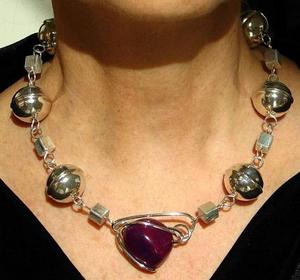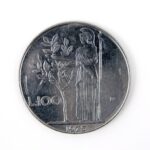Among the many precious metals used in jewelry, silver comes to mind. In this jewelry maker’s mind, there might as well be only two metals: gold and silver. I covered karat gold jewelry in a previous piece. It’s time now to get the scoop on silver.
Silver comes in two basic grades for jewelry: fine silver and sterling silver. Fine silver is pure or nearly pure, being 99.9% silver. It’s soft, malleable, and shows a brilliant shine. Sterling silver is 92.5% silver with the remaining 7.5% consisting of other metals, primarily copper but also germanium, platinum or zinc. Other metals are added in the alloy for imparting desirable properties, such as increased hardness and tarnish resistance. The stamp on sterling silver jewelry says ‘925,’ dropping the decimal point and percent sign as being unnecessary among those in the know.
Elemental silver is Ag. In Latin, silver is argentum, accounting somewhat for the choice of letters for silver’s symbol on the periodic chart of the elements. There’s a kind of sterling silver called ‘Argentium Silver.’ If you ask me, that name means silver silver, a confusing tautology. It contains 97% silver; the rest is germanium, which is added for tarnish resistance. The 3% germanium in Argentium Silver is an assumption, as the manufacturers don’t say so specifically. Perhaps they want to keep the precise formulation a trade secret. But germanium is definitely in there. Further obfuscating the issue, Argentium Silver carries the 925 sterling silver designation despite having more than 92.5% silver in the alloy. Go figure!
I like Argentium Silver for silver jewelry because it doesn’t tarnish nearly as much as sterling silver. Tarnish cannot be avoided no matter how well you store or care for your silver jewelry. Oxygen in the air is the oxidizer that tarnishes silver. So does sulfur, with some regions of the country having it in the air at mere parts-per-million levels. That’s not much at all, but it’s enough to tarnish silver over time. And soaking in natural hot springs with silver jewelry on is a no-no. It will tarnish your silver jewelry as you approach the tub! So leave your sterling silver jewelry, even jewelry made of Argentium Silver, at home when heading out to sulfurous springs, commercial spas, or hot tubs. Unless, of course, you like your silver jewelry black.
For those of us who don’t, there are at least three good ways to clean away tarnish. Light tarnish is that yellowy film that dulls the shine on sterling silver jewelry. Most gals live with it, perhaps not noticing it at all. I don’t like it. I’ve got to get it off. It ruins the reason you got sterling silver jewelry in the first place: for the shine!
A silver polishing cloth will do the trick well on light tarnish. Sunshine silver cloths are a popular brand with dozens more on the market that work just as well. To get into fine places, wrap the tip of a toothpick or small screwdriver with the cloth and rub gently. The more you rub, the shinier the silver gets. The truth be known, vigorous rubbing with any soft, clean cloth will also remove light tarnish from accessible silver surfaces. Removed tarnish shows as black on the cloth.
Medium tarnish responds well to silver paste cleaning. However, the paste can be difficult to remove completely from crevices and will tend to remain in intricate places. Paste can be removed with the toothpick or screwdriver method when covered with a soft, clean cloth.
Heavy black tarnish, or removal of tarnish from places you simply can’t get to, does well with silver dip. Folks are afraid of silver dip. With all the warnings about not using it on this or that gemstone, I found silver dip to restore the original silvery shine in an instant. A dunk in Goddard’s Silver Dip will do it. Just don’t dunk gemstones that are 4 or less on the Mohs scale in the dip. Clean the silver around such gemstones with a cotton swab wet with silver dip. Rinse the entire jewelry piece in clear running water. Voila, shine! Even pearl jewelry finished in silver can be cleaned in this way.
Jewelry is said to tarnish even more quickly after silver dip cleaning. A way to avoid this is to polish the silver with the polishing cloth after the silver dip treatment. A very thin film of polish seems to protect the newly cleaned silver from rapid re-oxidation.
The best thing you could do for all your silver jewelry is to wear it often and give it a little rub with the cloth before putting it on. Your silver jewelry will remain as shiny as the delight you derive in wearing it tarnish-free!
Sources: personal experience; I know this stuff.



